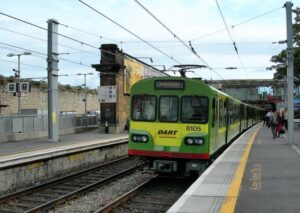by The Cowl Editor on January 18, 2019
Creative Non-Fiction

by Jay Willett ’20
“No legs up-50 euro fine.” The text enraged me as I promptly took my seat on the pea green cushion. Defeated, I took a breath and in the bat of an eye, we arrived at Tara Street. Suddenly, the cabin was crowded and populated by flocks of tourists, bumping against each other without empathy. Five-no, six men, aged around mid-20’s, sat behind us. I could tell their age not by their looks, but by their voices. The men poked fun at each other, exclaiming in Spanish how one person in their group wore a tacky outfit.
“Tu ropa!” they all laughed, pointing at the one man who had his cuffs up in the air. I chuckled in my seat. The fact was, they all wore the same looking clothes: a blue collared button down, jeans, the works. I struggled finding the difference that they were bullying him for. They were all quite tan, wore patchy dark beards, and flashed sizable smiles for the majority of the trip. The Spaniards looked like they were having fun, I thought as I looked down at my offbeat donut, taking a bite. Quickly, we zoomed past tenement-looking places, cranes, pillars of smoke funneling to the heavens, graffiti, “TAKE BACK THE CIT-”
“Harmonstown,” crackled the P.A. I sighed and reclined in my seat. Not long now until we reach the end of our journey, the end of the line. A city of the past, ruined castles and churches, I daydreamed of our destination. Remember the past, live the present, scratch the third.
Our Spanish friends increased in volume, their voices reached new heights when the bullied man chirped back. He cursed them in Spanish, smiling while he did it, and sat back down laughing with the rest of the chorus. I looked back at us, our heads buried in our phones, giving the occasional chuckle when we scrolled through Barstool’s feed. Both groups were from different countries, and both were traveling to the same destination-the past. In that brief moment, just the second before passengers got up to wait for the sliding doors to open, I felt jealous. Though some of our group winced in annoyance at the men, the whole ride I thought to myself, “I want that to be me.”
New relationships, new connections, that’s what study abroad is all about, alumni say. I don’t particularly enjoy restarting though. It’s scary, to know that your friends, your group of Spaniards, are just about an ocean over. Howth, that’s what the LED sign read, as I passed underneath. The land of the ocean, maybe I’ll get a glimpse of home today, I thought.
* * * *
The worst thing about Iceland isn’t its precipitation, it’s the wind. The flakes creep in between the gusts, causing dandruff on the stones. The first snow in a couple of days, and of course, it arrives along with 70 knot gales. Even at the base of the mountain, or volcano, whatever it is, the winds are relentless and trample over the burial grounds. Despite the vast space, it’s all mostly sulphuric lava fields surrounding the church, limiting the graves to a 10-meter-wide section of land. You can’t dig through lava fields, you’ll get too tired and give up or receive a face-full of fresh geyser water, melting faces. The location made sense then, but the church? Ratty, the cloth holding the door to its frame is tattered. The rustic paint only clings to the shingles just to match the faintness of its now dangling door. Locals recount that taxes provided opportunity for farmers to avoid fees and collect a handsome sum from the pool of their peers. How disappointing.
A half hour out from Reykjavik, but there’s nothing to hint that civilization might be close by. The looming mass of land blocks the city, and the road that bends around takes a detour just south to avoid simplicity. They’re just rocks now. There are no names to pay respects to, wiped and scratched Icelandic symbols aren’t legible, even in their native tongue. A tiny fenced-in area among the tundra seems to be hard to upkeep. The wind carves its share into the curves of the gravestones, leaving them disfigured like a used deodorant stick. Maybe standing there awhile in the 2 degrees Celsius air is respect enough, but the elusiveness of names leaves a bitter taste. Without them, the stones are nothing but that, formations holding back against the undying tide of the wind.
The dirt is stiff, the labor for even the five rows of graves would have taken forever. Driving another 10 minutes will reveal another neighboring farm, with an identical church and yard. Maybe there aren’t bodies under the ice, maybe the markers are meant to legitimize the church, drawing in more hungry customers. I, for one, don’t have the appetite for that type of theology.
Back on the bus, our guide resumes the details of her love life. The heavy snow conquers and outranks the wind’s blast and blankets the stones to hide them from any more peering tourists. I regret touching the stones, as my fingers are crusted with frost and a bright vermillion. Next is the waterfalls, but yet, the image of the lonely church at the base hogs my excitement. The once plentiful yellow sulphur is now buried under the neat coat of white, concealing the farmland from view. Questions surface to my mind. How could they use religion for profit? Are there no morals? Maybe I’ll ask the questions when our guide is done listing her first date experience. Then again, the answers could come to me in a moment, such uses are probably more foreign to them than it is to me.